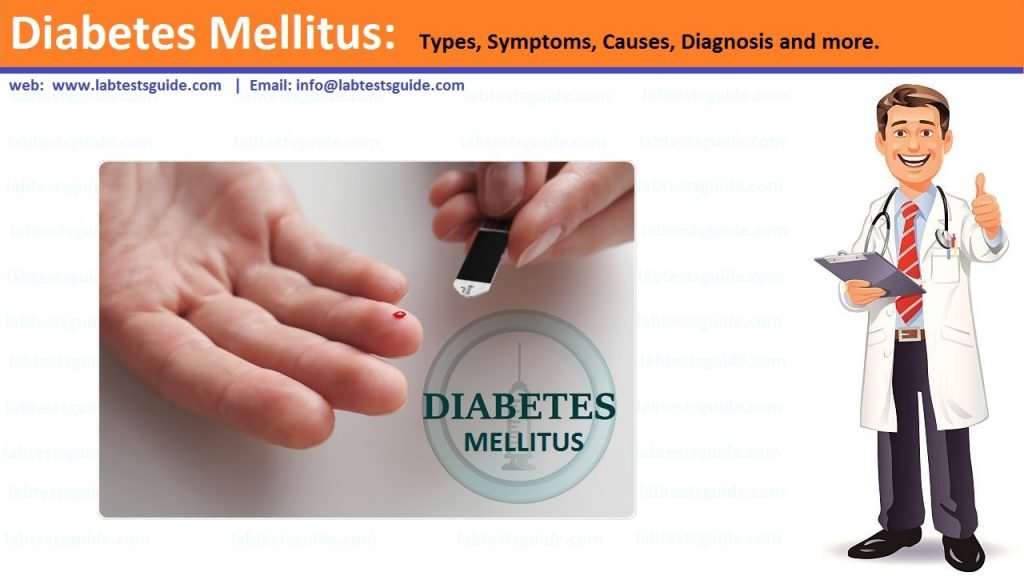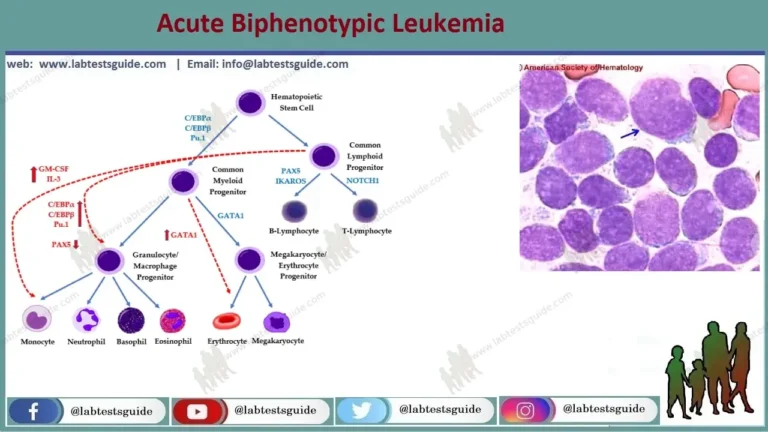Also Known As: Diabetes mellitus, Blood Sugar, Blood Glucose, Glucose
Related Diaseases: Kidney Diseases, Pancreatic Diseases, Heart Disease, Heart Attack, Stroke, Metabolic Syndrome, Acidosis and Alkalosis, Neuropathy, Pregnancy

Definition of diabetes mellitus:
- Diabetes mellitus is a group of metabolic disorders of carbohydrates metabolism in which glucose is not properly utilized, leading to hyperglycemia.
- Criteria for the diagnosis of diabetes Mellitus:
- Polyuria, polydipsia and rapid weight loss.
- Insulinopenia decreased insulin due to the loss of β-cells of the pancreas.
- Most patients have autoantibody were called an autoimmune process.
- While no cause known is called idiopathic type.
Type of Diabetes Mellitus:
- Type 1 diabetes mellitus is insulin-dependent/ juvenile-onset and its types are:
- Autoimmune type.
- Idiopathic type.
- Type 2 diabetes mellitus is non-insulin dependent or adult on set type.
- Patients have minimal symptoms.
- This is not dependent on insulin to prevent ketonuria.
- The insulin level may be normal or decreased or increased.
- Most patients have impaired insulin action.
- Gestational diabetes mellitus.
- This is first diagnosed during pregnancy.
- Already known cases of diabetic women are not included in this group.
- This occurs in 6 to 8% of the pregnant ladies.
- These ladies are at increased risk later on to develop diabetes mellitus (6 to 62% of these ladies).
- Impaired glucose tolerance (IGT).
- This group has less fasting glucose than required for diabetes mellitus.
- An oral glucose tolerance test is needed to diagnose this group.
- The overt case develops 1 to 5% per year.
- Microvascular diseases are very uncommon in this group.
- Impaired fasting glucose (IFG).
- This is diagnosed by fasting glucose values between normal and diabetics individuals.
- This is a metabolic stage between normal glucose and diabetes mellitus.
- There is an increased risk for the development of diabetes and cardiovascular disease.
Latest classification criteria for diabetes mellitus
- Diabetes mellitus:
- Presence of classical symptoms.
- If fasting glucose level 126 mg/dl (>7.0 mmol/L) or above should be labeled as D. Mellitus (when this value is found two times).
- One random glucose level of more >200 mg/dl (11.1 mmol/L) with symptoms of polyuria, polydipsia, and polyphagia are considered diagnostic of diabetes.
- HbA1c more than 6.5 % diagnostic for Diabetes.
- The 2-hour postprandial glucose level of ≥200 mg/dl (11.1 mmol/L) during OGTT.
- Impaired fasting glucose = > 126 mg/dl. (fasting glucose level 110 to 125 mg/dL (6.1 to 7.0 mmol/L).
- Impaired glucose tolerance when:
- Fasting glucose < 126 mg/dl (7 mmol/L).
- OGTT 2 hours sample is 140 mg to 199 mg/dl (7.8 to 11.1 mmol/L).
Criteria for the diagnosis of diabetes mellitus
- Fasting blood glucose level:
- 126 mg/dL (7.0 mmol/L) or higher is considered diagnostic.
- Random/ non fasting blood glucose level:
- 200 mg/dL (11.1 mmol/L) is diagnostic.
- Oral glucose tolerance test with 75 G of glucose:
- 2-hour sample 200 mg/dL (11.1 mmol/L) or higher value is diagnostic.
Possible References Used





